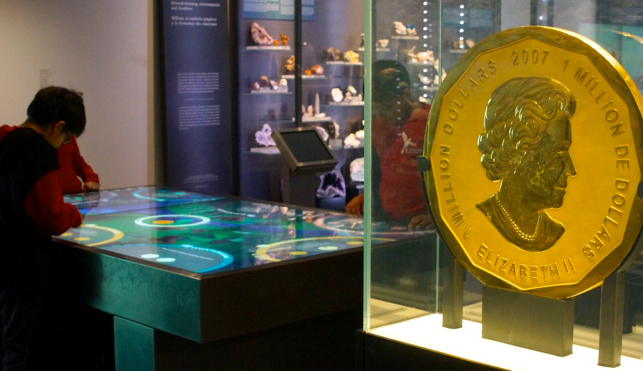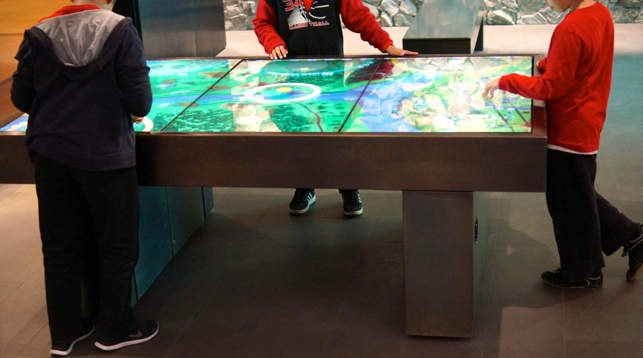Featuring an 8-panel video wall and a 65” touch-screen display (from NEC) this installation is the first of its kind in Canada. It’s set up to show behind-the-scenes moments and enable fans to purchase exclusive sports memorabilia.
Launched last week, MasterCard teamed up with Maple Leaf Sports & Entertainment to create the Priceless Toronto Zone, allowing fans to interact with video content on the big screen and use their mobile phone to complete the transaction.
The Priceless Toronto Zone is currently set up to entice fans to buy sports memorabilia during Raptors and Leafs games. In a few simple steps, you can browse and purchase from a selection of collectible bobble-heads featuring the likeness of Raptors and Leafs mascots and players.
If you’re a Canadian MasterCard cardholder or MasterPass account holder, you can buy one of these collectible figures for $15.99. All net proceeds are being donated to the MLSE Foundation, which aims to improve the lives of youth by building facilities, giving to sustainable programs and empowering youth through sports and recreation.
Adjacent to the interactive screen is an 8-panel video wall where video content is likely to be streamed. There’s also a kiosk-like area on the other wall that looks like it’s supposed to entice fans to register with Priceless Toronto on one of four iPads secured to the wall at about hip-level. These small screens by comparison appear more like an afterthought to the whole interactive digital experience.
MasterCard has also now outfitted its food-and-beverage concession stands with contactless Tap & Go technology, enabling fans to quickly pay with the tap of their MasterCard to ensure they don’t miss a moment of the action.
All photos by Roger Cullman.
The gallery, located in the ROM’s Teck Suite of Galleries: Earth’s Treasures (Level 2), is an interactive 600-square-foot space with multi-touch, animated displays and multi-media presentations.
Just inside the gallery you’ll find the world’s largest gold coin, a 100 kg $1M gold coin enclosed in a glass display case. While this specimen is untouchable, the interactive Game Table behind it is meant to be touched.
Comprised of three 55″ screens (each measuring 48″ x 27″) the Game Table stands about waist-high, enabling easy hands-on access to the display. Users are encouraged to drag-and-drop icons around the screen by tapping coloured circles and swiping their fingers along the backlit surface. Each gesture they make results in a measurable outcome in the mining process shown on the screens.
Users learn about the challenge of modern mining and get to manage the delicate balance between production and sustainability. In essence, they’re finding out how similar real-world decisions would impact the future of mining — while having fun interacting with this display. Think of it kind of like The Sims game in microcosm. There’s also an iOS app called ROMining that’s works much the same way on mobile devices.
Adjacent to the Game Table is a four-panel Touch Wall that features images, illustrations and text that let visitors explore the extent of our reliance upon the products of mining, encouraging them to make responsible decisions in consuming valuable resources.
“This project took over two years from conception to launch and a year to develop and implement the two interactive installations in the Gallery,” says Courtney Murfin from the ROM’s Interpretive Planning department.
“Both interactives were conceptualized in house by the ROM, and content was also developed by the ROM. We undertook two rounds of scheduled/facilitated user testing over two months, followed by three months of further development updates and testing.”
The hardware used for the screens are MultiTaction screens from MultiTouch Ltd.. Independent Toronto companies developed the systems for both the Touch Wall (Meld Media) and the Game Table (Aesthetec Studio).
The Game Table and the Touch Wall are now a permanent part of the Barrick Gold Corporation Gallery of Mining, providing the most advanced, hands-on, user-driven visitor experiences at the ROM.
“You can experience all the safety functions in a safe simulator experience and get first-hand experience,” Andreas Gottschol, an engineer with Mercedes-Benz in its Active Safety department explained as he described the driving simulator. “It shows off all the safety functions in the S-class (as well as the E- and C-class) vehicles.”
There are six screens in front of the car and 11 graphic simulation channels. Behind the scenes is a network of 12 powerful computers. And there is a compiler in the trunk telling what the simulation offers is real.
“Technology like this took one year of development time,” says Gottschol. “This is the 4th generation of simulators now.”
The Mercedes Driver Simulation was first introduced at a world press event in Toronto, says Haab. It was also shown in the Frankfurt Auto Show in September 2013 and there are plans to show it off in Stuttgart and Washington.
“From an interactive experience, you keep it a lot more in your mind than just reading about it. Or compared to a regular test drive,” adds Jochen Haab, another Mercedes engineer.
The main audience so far has been the media and potential customers at the big auto shows. But the intention is to eventually take large driver simulation displays like this on the road to large events in dealerships, providing customers with a more immersive experience without the potential dangers of doing so on a test drive scenario.












